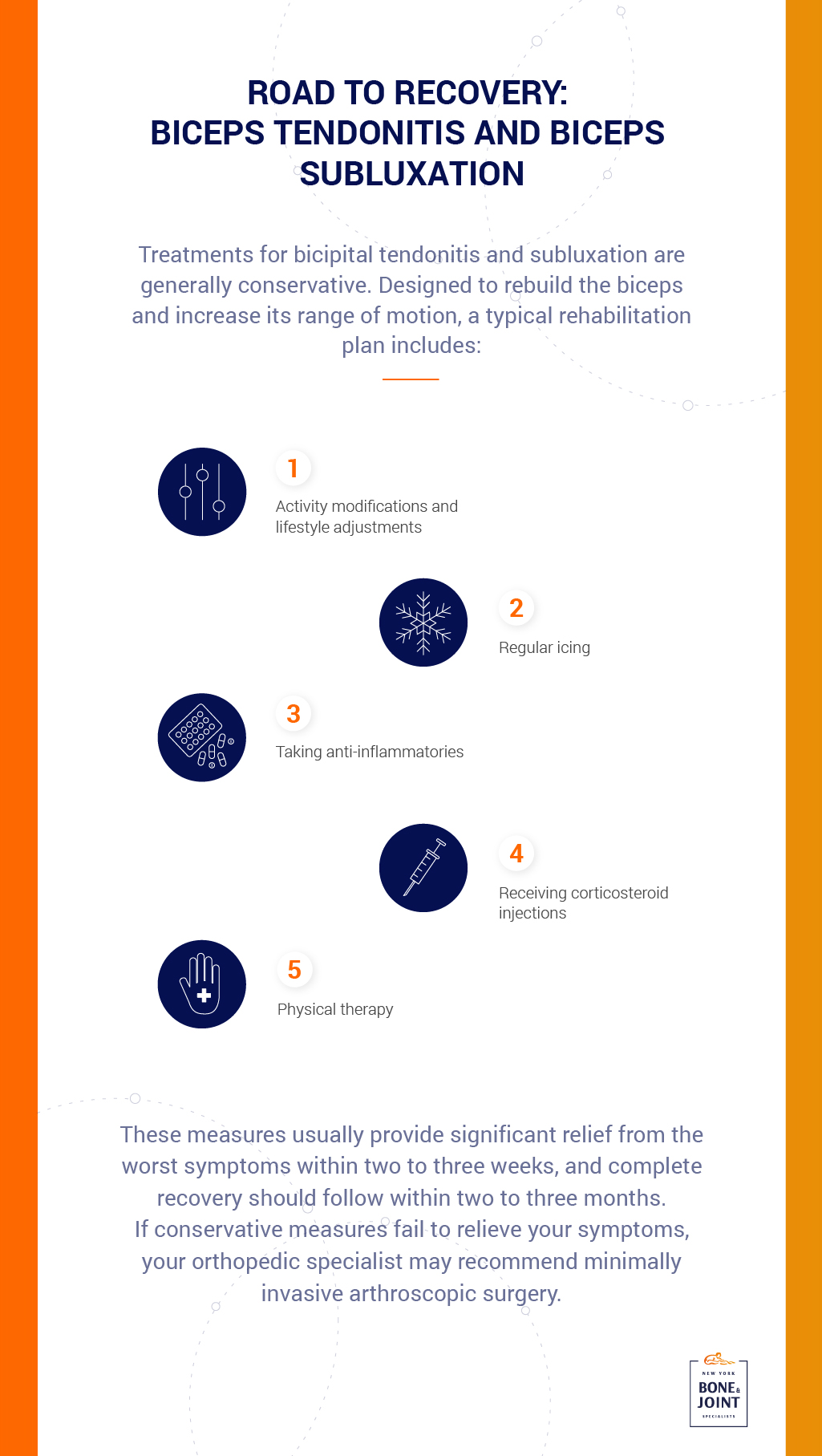WHAT IS BICEPS TENDONITIS?
Bicipital tendonitis is an inflammation of one of several tendons that connect the biceps to the shoulder. It most commonly affects the upper tendon, which joins the biceps and the socket of the shoulder joint. The condition is often accompanied by other disorders such as rotator cuff tears, labral tears, shoulder impingement, and biceps subluxation.
WHAT IS BICEPS SUBLUXATION?
Biceps tendonitis is often caused by biceps subluxation, a condition that results in chronic instability in the upper biceps. It occurs when the long head tendon is repeatedly dislocated from the bicipital ridge, a groove at the front of the shoulder that leads to the joint. Biceps subluxation can associated with damage to the subscapularis rotator cuff tendon.
BICEPS TENDONITIS AND BICEPS SUBLUXATION SYMPTOMS
The most common symptom of bicipital tendonitis and subluxation is moderate to heavy pain at the front of the shoulder, which may become more severe when lifting objects overhead. A patient with a subluxing biceps might also notice a clicking sensation in the front of the shoulder.
Other common symptoms include:
- A sense of weakness or tenderness in the affected shoulder
- An ache that radiates along the upper arm
- A sporadic popping or snapping sound
BICEPS TENDONITIS AND BICEPS SUBLUXATION TESTS
Biceps tendonitis can be diagnosed with a simple physical examination conducted by a qualified orthopedic specialist. Your doctor will likely hold the shoulder at a ninety degree angle while rotating the humerus, or apply pressure to the biceps while you resist it. Your orthopedic specialist will determine whether the biceps is subluxing by feeling for a palpable click when rotating your arm. In addition, they’ll test the strength of the rotator cuff, and the subscapularis tendon in particular. In some cases, your doctor may order an MRI and X-ray after your physical to assess the extent of the damage to the biceps itself, the rotator cuff tendons, and the labrum or cartilage.
BICEPS TENDONITIS AND BICEPS SUBLUXATION TREATMENT & RECOVERY
Conservative
Treatments for bicipital tendonitis and subluxation are generally conservative, with most doctors preferring to avoid surgery whenever possible. The most common conservative treatments include:
- Refraining from all activities that might exacerbate the condition
- Icing the affected tendon in a wrapped towel several times a day for 20-minute intervals
- Reducing pain and swelling with anti-inflammatories or corticosteroid injections
- Physical therapy focusing on strengthening exercises designed to rebuild the biceps and increase its range of motion
While recovery timelines vary from patient to patient, conservative treatments for biceps tendonitis and/or subluxation usually provides significant relief from the worst symptoms within two to three weeks. Complete recovery generally follows within two to three months.
Surgery
Should conservative measures fail or a rotator cuff tear be present, bicipital tendonitis and/or subluxation can also be treated with a short arthroscopic surgery. During this procedure, your surgeon will either debride the torn biceps tendon, reattach the tendon to a more secure location on the bone, or simply release the biceps tendon without re-attaching it. The ultimate course of treatment largely depends on the severity of the symptoms, the extent of the damage to the tendon, and the age of the patient.
As a minimally invasive procedure, bicipital surgery is designed to shorten recovery timelines and reduce the risk of complications. While you will generally need to wear a sling for several weeks, you will be able to resume daily activities such as writing and typing immediately, and begin physical therapy within a week or two of the procedure. With regular rest and a rigorous physical therapy program, you can expect to make a complete recovery within four to six months.










